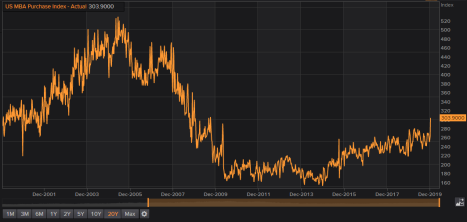Vital Statistics:
| Last | Change | |
| S&P futures | 3251 | -21.25 |
| Oil (WTI) | 52.38 | -0.92 |
| 10 year government bond yield | 1.57% | |
| 30 year fixed rate mortgage | 3.71% |
Stocks are lower on mixed earnings reports. Bonds and MBS are up.
The Fed made no changes to monetary policy, however they did tweak some overnight lending rates. The interest on overnight excess reserves and reverse repo transactions were hiked by 5 basis points to 1.6% and 1.55% respectively. The vote was unanimous. The Fed Funds futures became more dovish, with the Dec futures predicting an 85% chance for a cut of some sort, and a 15% chance of no change. Interesting to see the move in the Fed Funds futures given that the Fed actually tightened slightly by increasing the reverse repo and interest on overnight reserve rates.

GDP rose at 2.1% in the fourth quarter of 2019, a little bit higher than expectations. Consumption growth slipped to 1.8%, while inflation remained broadly in check. The PCE index rose 1.5%, while the core PCE, excluding food and energy rose only 1.3%. Residential construction rose 5.8%. The trade balance moved in the US’s favor, which also helped growth.

Initial Jobless Claims came in at 216,000.
Pending Home Sales decreased 4.8% in December according to NAR. “Mortgage rates are expected to hold under 4% for most of 2020, while net job creation will likely exceed two million,” said Lawrence Yun, NAR’s chief economist. “Due to the shortage of affordable homes, home sales growth will only rise by around 3%,” Yun predicted. “Still, national median home price growth is in no danger of falling due to inventory shortages and will rise by 4%. The new home construction market also looks brighter, with housing starts and new home sales set to rise 6% and 10%, respectively.”
Filed under: Economy, Morning Report | 43 Comments »






